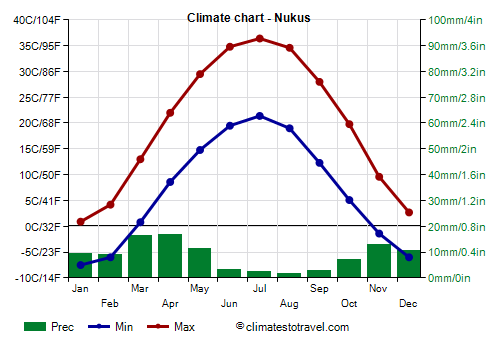Select units of measurement for the temperature and rainfall tables (metric or imperial).
Average weather, temperature, rainfall, sunshine hours

The climate of Nukus is
arid continental, with very cold winters and very hot, sunny summers.
Nukus is a city of 330,000 inhabitants, located in the north-west of Uzbekistan, in the autonomous republic of Karakalpakstan, of which it is the capital, and at 42 degrees north latitude. The border with Turkmenistan is a few kilometers to the south.
The Amu Darya River, which passes through the city, together with the Syr Darya once fed the
Aral Sea, a large salt lake located in the north-west of the country and shared with Kazakhstan, which over the decades has almost completely dried up due to exploitation for agriculture. The southern shore of the lake was once located 145 km (90 mi) north of Nukus.
Precipitation is decidedly scarce, around 105 millimeters (4 inches) per year. Summer is the driest season.
Winter, from December to February, is cold: the average temperature in January is about -3 °C (26.5 °F). Due to its northern location, winters in Nukus are colder than in the major cities of Uzbekistan, which are located further south.
Sometimes, southerly winds can bring mild air, so much so that temperatures can reach, and sometimes exceed, 15 °C (59 °F).
Fog can form during periods of stable weather.
Due to the arid climate, snowfall (and rainfall when temperatures are above freezing) is generally light.
During
cold waves, the temperature drops every year to -15 °C (5 °F) or below. Occasionally it can even drop below -30 °C (-22 °F). The last time it happened was in January 2008, with -30.8 °C (-23.4 °F).
Summer, from June to August, is very hot and sunny. The average for July is 29 °C (84 °F). Humidity, however, is low.
On the hottest days, temperatures reach or exceed 40 °C (104 °F) every year, and can sometimes reach 45 °C (113 °F). In August 2002 it reached 46.8 °C (116.2 °F).
In July 2019, the average high was 38.6 °C (101.5 °F).
Nukus - Climate data
In Nukus, the
average temperature of the coldest month (January) is of
-3.3 °C, that of the warmest month (July) is of
28.9 °C. Here are the average temperatures.
Nukus - Average temperatures (1991-2020) |
| Month | Min | Max | Mean |
|---|
| January | -7.5 | 0.9 | -3.3 |
|---|
| February | -6 | 4.2 | -0.9 |
|---|
| March | 0.8 | 13 | 6.9 |
|---|
| April | 8.6 | 22 | 15.3 |
|---|
| May | 14.8 | 29.5 | 22.2 |
|---|
| June | 19.5 | 34.8 | 27.2 |
|---|
| July | 21.4 | 36.4 | 28.9 |
|---|
| August | 19 | 34.6 | 26.8 |
|---|
| September | 12.3 | 28 | 20.2 |
|---|
| October | 5.1 | 19.8 | 12.4 |
|---|
| November | -1.4 | 9.6 | 4.1 |
|---|
| December | -6 | 2.7 | -1.6 |
|---|
| Year | 6.8 | 19.7 | 13.2 |
|---|
amounts to
105 millimeters per year: it is therefore at a desert level. It ranges from
1.7 millimeters in the driest month (August) to
16.6 millimeters in the wettest one (April). Here is the average precipitation.
Nukus - Average precipitation| Month | Days |
|---|
| January | 10 | 11 |
|---|
| February | 9 | 9 |
|---|
| March | 16 | 9 |
|---|
| April | 17 | 8 |
|---|
| May | 12 | 8 |
|---|
| June | 3 | 5 |
|---|
| July | 2 | 3 |
|---|
| August | 2 | 2 |
|---|
| September | 3 | 3 |
|---|
| October | 7 | 5 |
|---|
| November | 13 | 8 |
|---|
| December | 11 | 10 |
|---|
| Year | 105 | 81 |
|---|